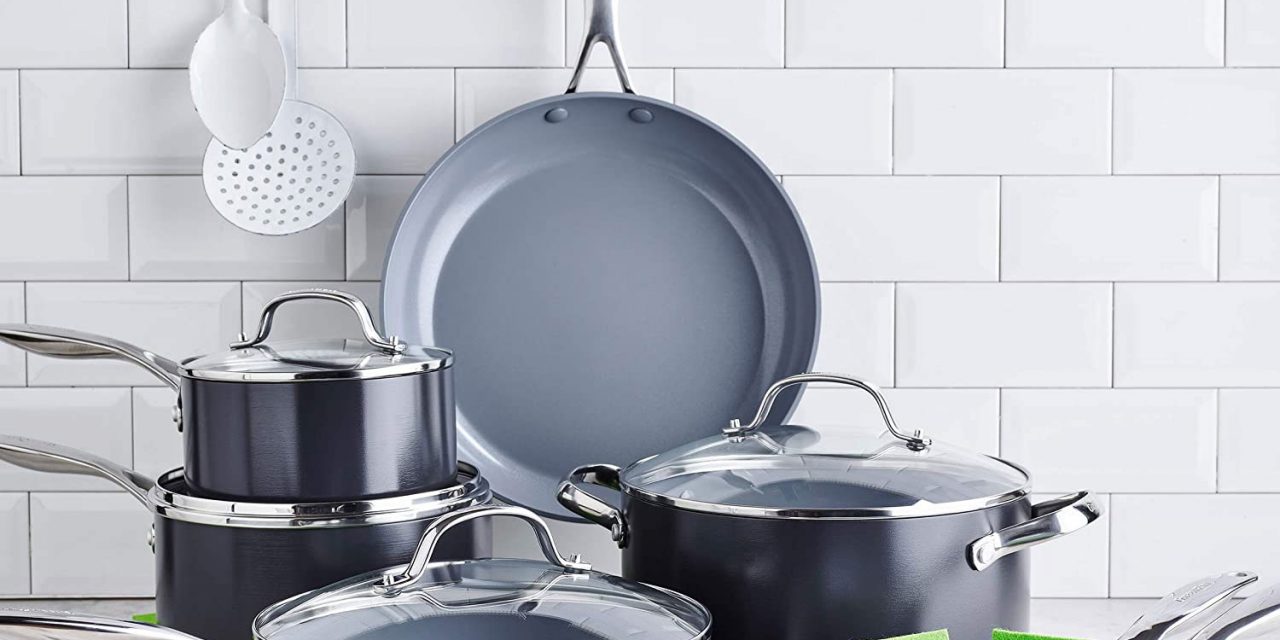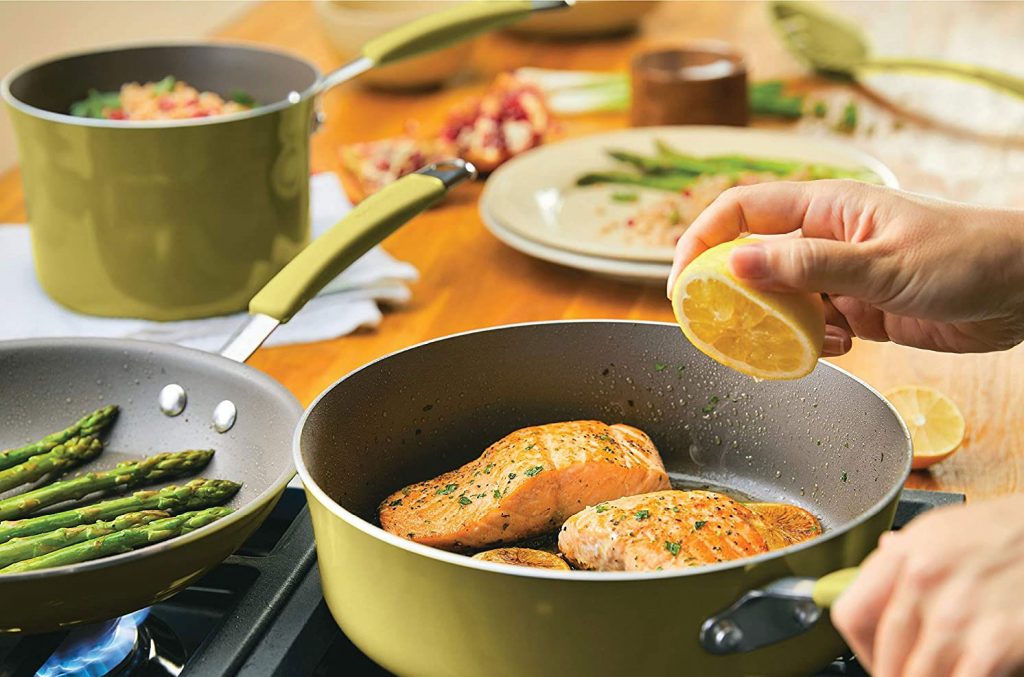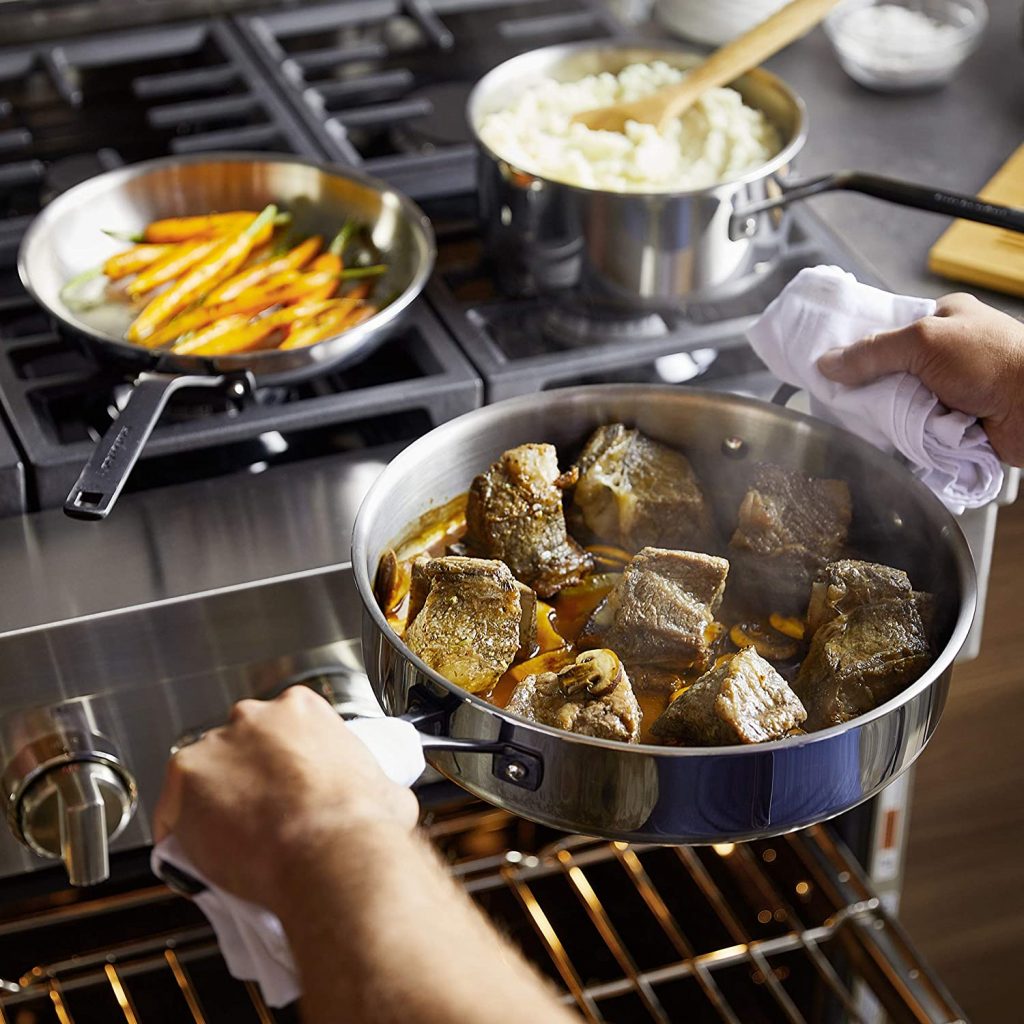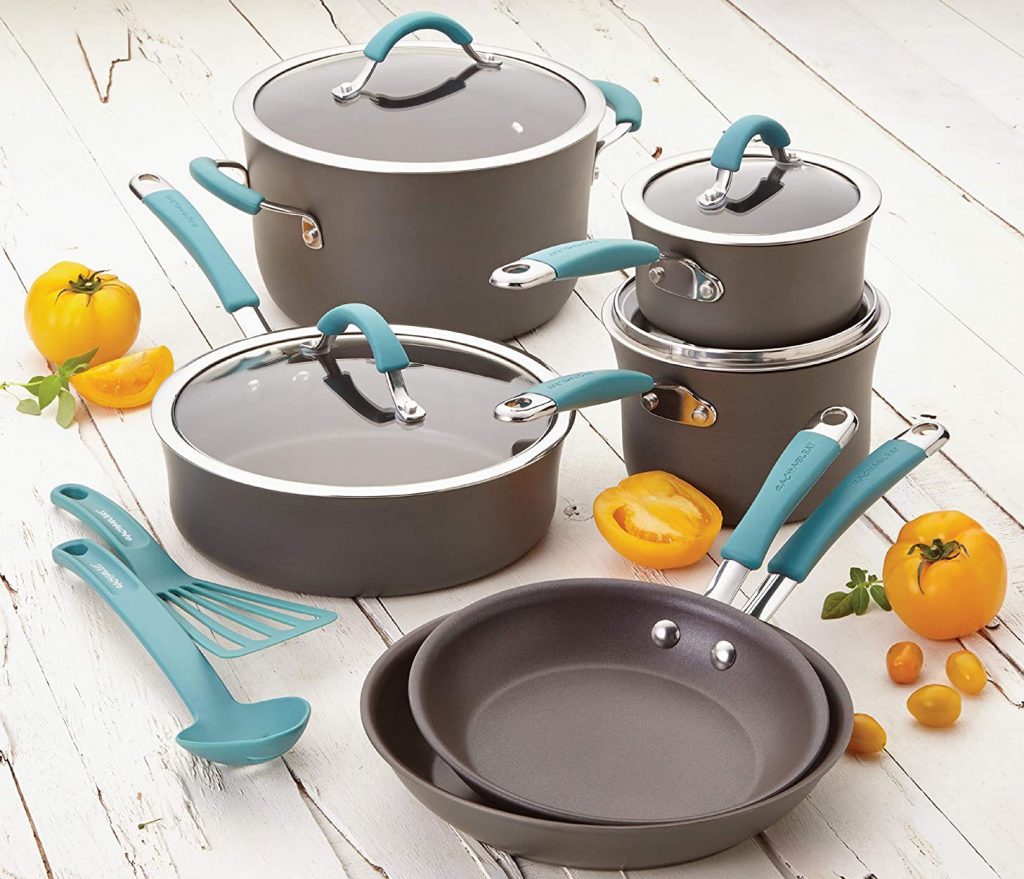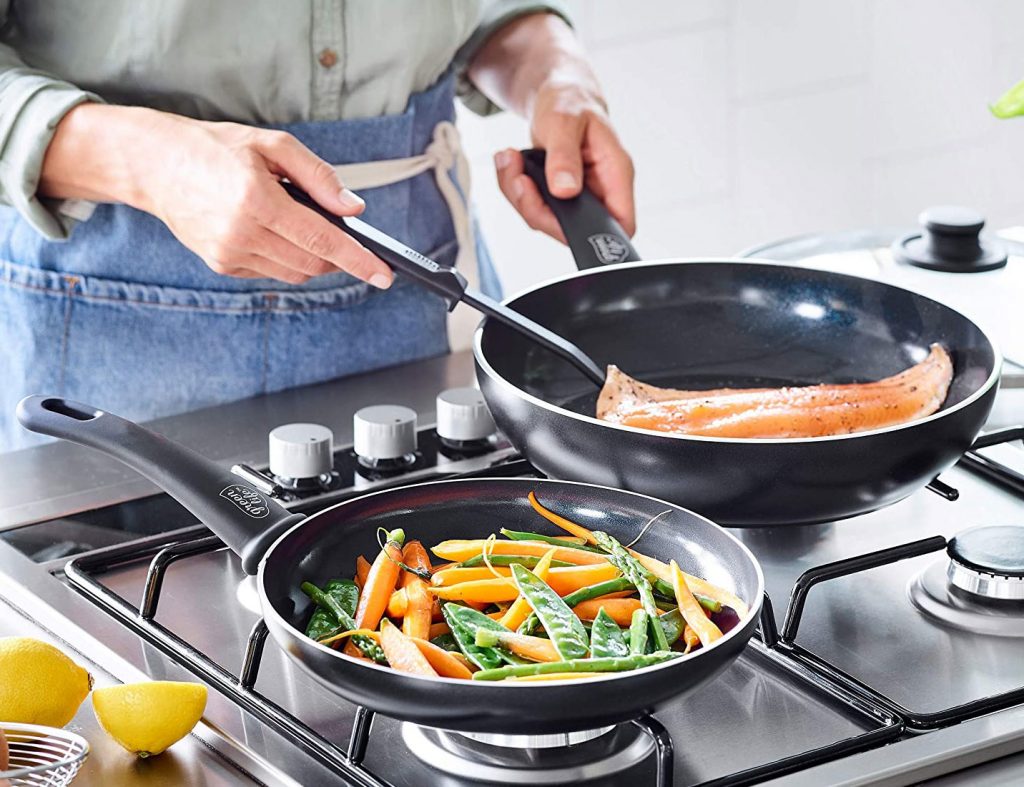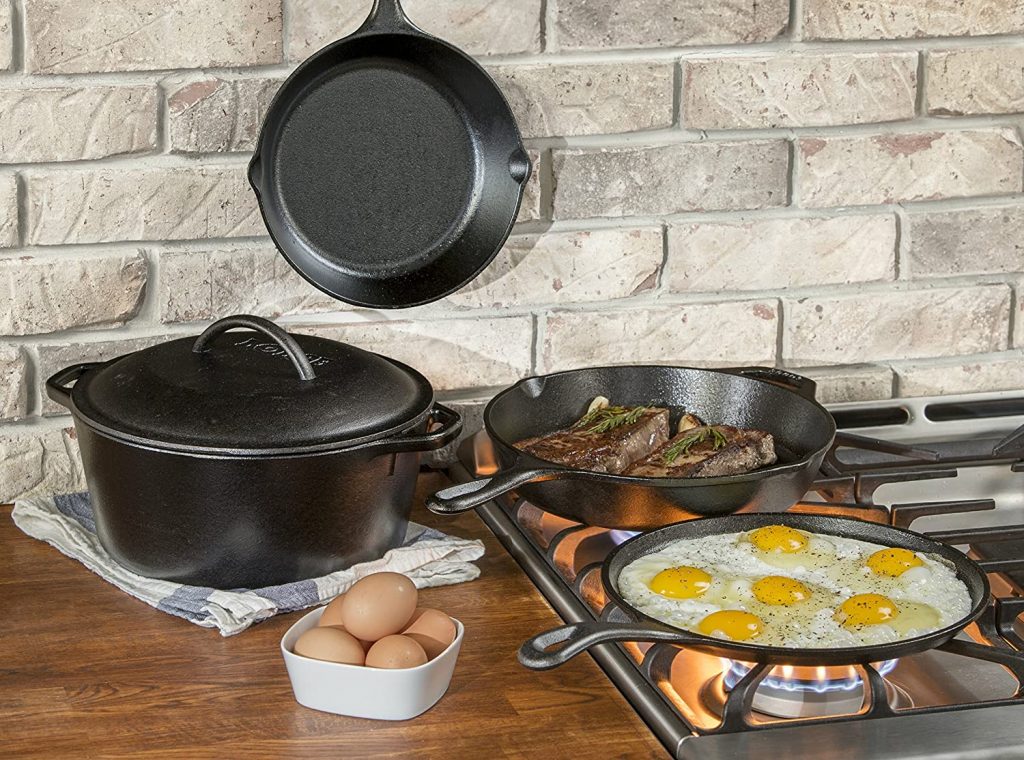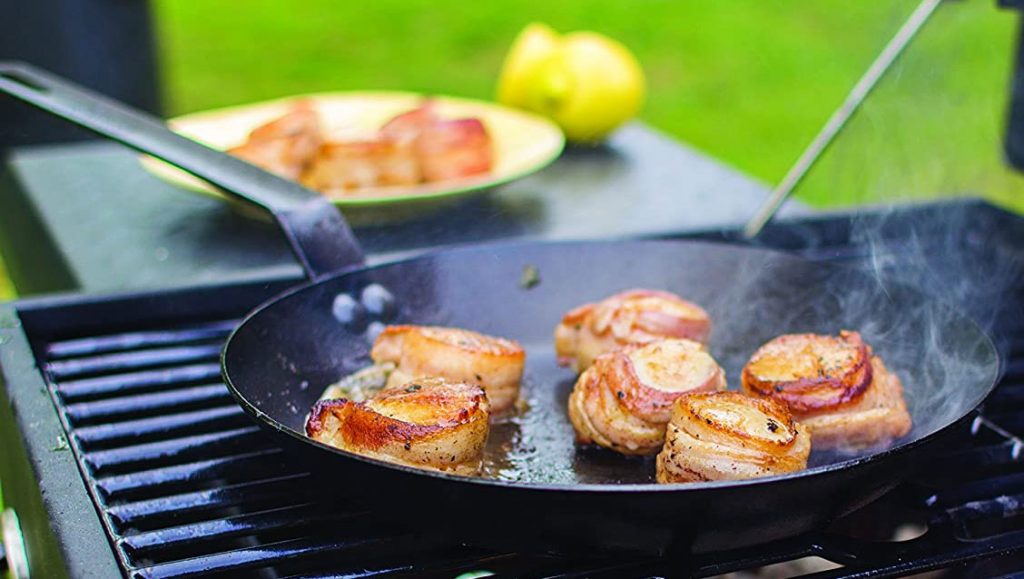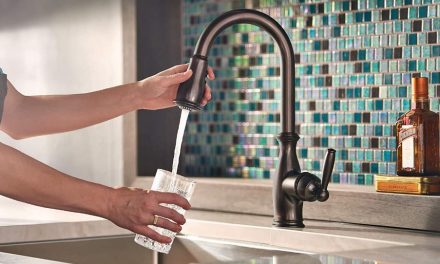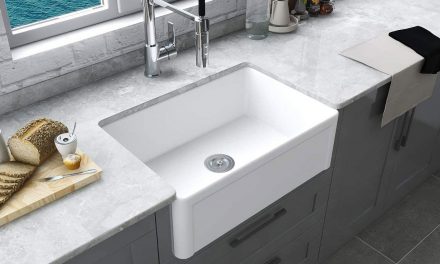Most cookware sets aim to cover all the common scenarios you might encounter in your kitchen. For this reason, they always focus on pots or pans of various sizes. Large sets may also include strainers, cooking utensils, and baking sheets.
There are many different cookware brands and set variations on the market, with most sets having 10-15 items or pieces in them. If you’re uncertain why one type of cookware set costs $150 and another type costs $700, it boils down to materials and finishes, as well as the cookware’s heat conductivity and general durability.
Table of Contents
Types of cookware sets and cookware materials
While it may seem like choosing a cookware set simply comes down to picking the set with the right number and type of pieces you may want, really what you want to focus on is materials and finishes. This is the real difference between different types of cookware sets. There is no universally amazing cookware material or finish. They all come with their share of pros and cons, and over time you’ll probably find your kitchen has use for multiple types.
Nonstick cookware (Teflon and other PTFEs)
Many types of cookware claim to be nonstick. While it’s true that anodized aluminum, ceramic-like coatings, and seasoned cast iron can be relatively nonstick, the only true nonstick cookware comes with a thermoplastic coating, the most well-known brand of which is called Teflon.
True nonstick cookware is great for cooking eggs, rouxs, and fish, but you'll see less benefit from it with many other foods. Sure, no one wants their food to really stick while cooking, but a complete lack of stickiness isn't necessarily desirable for all kinds of cooking, either. For instance, nonstick cookware won't give you the same flavorful browning on meats, like chicken breasts.
The biggest practical drawback to nonstick coatings is their durability over time. Even when using nonmetal utensils and hand-washing the cookware after every use, these coatings will eventually break down, especially with continued exposure to high temperatures or if you clean them in the dishwasher. Expect to replace this cookware periodically. The good news is that even large nonstick cookware sets tend to be highly affordable upfront, meaning replacing the occasional pot or pan won’t break the bank.
Pros
- Truly nonstick cooking makes stirring and cleaning easier
- Less oil is needed while cooking, making foods less fatty
- Inexpensive
Cons
- Better for some foods than others
- Must use plastic, silicone, or wooden utensils
- Not dishwasher-safe / won’t last well when cleaning in dishwasher, must be hand-washed
- Should replace at the first sign of the nonstick finish's deterioration
- Known and possible health concerns, especially at high temperatures (see below)
Price range: Highly affordable, and you won't see too many high-end cookware sets with PTFE coatings
Are nonstick surfaces safe?
Unless you've been living under a rock, you've probably seen at least one headline about the dangers of Teflon and other nonstick coatings, but is there cause for all this concern? Unsurprisingly, it's complicated.
Polytetrafluoroethylene, or PTFE, is the fluoropolymer behind most nonstick coatings, including the well-known brand of Teflon. You may also see perfluorooctanoic acid, or PFOA, mentioned. This was a surfactant that was used in PTFE processing, though companies argued it burned off during manufacturing.
Due to PFOA's concerning abundance in the environment and some evidence of bad health outcomes in those who had worked in PTFE processing or lived near plants that processed PTFE using PFOA, PFOA has been phased out by American and many other cookware manufacturers, but it may still be present in some imported cookware. It is worth noting that the World Health Organization's International Agency for Research on Cancer labels PFOA as "possibly carcinogenic to humans."
Does this mean you shouldn't use PTFE nonstick? Not necessarily. Unmarred nonstick should be safe to use, and PTFE is chemically inactive, meaning the occasional flake in your food isn't likely to harm you. But be careful of overheating nonstick cookware, which can release toxic fumes, and know that continued use of chipped, scratched, or dented nonstick really just means you're eating nonstick, and no one wants that, no matter how inert the PTFE is.
If you're concerned about safety, but want the benefits of nonstick, buy PFOA-free nonstick cookware that's been manufactured in countries known to have greater quality control, and be committed to careful use.
Stainless steel and aluminum cookware
Aluminum and stainless steel make up the bulk of cookware metals, particularly on the affordable end of the market. Because of their contrasting and complementary functions, the two are often seen layered together and may even feature nonstick finishes.
Extremely common and lightweight, aluminum has its pros (cheapness, ease of use) and cons (prone to staining, warping). It's a great heat conductor, making it ideal for things like baking sheets, but it's also reactive, meaning it can easily stain and rust if it's not coated. Stainless steel is heavier and more durable, but a bad heat conductor.
When combined with or without a nonstick surface, these two metals offer a solid middle ground for the average consumer. Just take a look at their individual pros and cons in the table below, and you'll see why they work so well together.
This is a type of cookware where price has been a relatively good indicator of quality in test kitchens, though expensive, high-tech-sounding features have rarely proved useful. If you want to cook with stainless steel, shell out more money upfront for well-made, thick stainless/aluminum combo cookware that will last a lifetime, but don't bother getting caught up in buzzwords.
| Stainless Steel | Aluminum |
|---|---|
Pros
|
Pros
|
Cons
|
Cons
|
Hard-anodized cookware
Cookware manufacturers are always trying to find the best of all possible worlds. Aluminum is cheap and abundant, leading to appealing cookware price points, but it comes with downsides and often needs to be combined with other metals. This is where anodizing comes in.
Anodizing is a multi-step electrochemical manufacturing process that's used to make aluminum (and other metals) more durable. It's a manmade process that emulates a natural oxidation process. If you'd like to understand the science behind it, check out this video.
When aluminum is given an oxide finish, it becomes much more durable and resistant to corrosion and scratching. It also allows for the metal to be decorated with color in a way that doesn't mask its natural shine. Hard-anodized aluminum simply employs a more advanced anodizing process, leading to an even more durable product that is still affordable.
Anodized aluminum has the advantage of being nonstick without the use of PTFE nonstick coatings. This does not mean all anodized aluminum cookware forgoes nonstick coatings, however. If this you’re aiming to avoid PTFE nonstick, don’t assume hard-anodized aluminum is PTFE-free. Carefully study product details before making a purchase or consider some other cookware.
Pros
- Durable; actually stronger than stainless steel
- Affordable
- Can be nonstick without Teflon/PTFE/PFOA
Cons
- Can be dishwasher safe, but will last longer when washed by hand
- Can't use cooking spray on these surfaces
- May not work well on induction cooktops
“Ceramic” cookware
There are really two kinds of ceramic cookware. True, traditional ceramics are made of clay, baked in a kiln, and glazed. Ceramic-coated cookware is made typically of some metal, like aluminum, that has been coated with a ceramic-like layer for nonstick purposes. This layer isn't really ceramic; it's just finished with silicon that gives a similar, glossy appearance to glazed ceramics.
Ceramic cookware manufacturers claim their approach to nonstick is "greener" and "healthier" than traditional Teflon/PTFE nonstick coatings. It's true that there's no real reason why a silicon coating might pose health problems, but it's also true there's not a lot of research into it. In traditional ceramics, you should beware of potential lead exposure.
In general, ceramic-like silicon-coated cookware performs poorly in kitchen testing. It heats up fast and stays hot, making it difficult to cook certain foods, and food does tend to stick quite a bit more on it than it does to traditional Teflon/PTFE nonstick. Still, some companies' products stand out from the pack, with the downside being that the best ceramic cookware isn't cheap.
Pros
- Can be a decent alternative to nonstick coatings
- Doesn't release toxic fumes at high temperatures
- Material allows for colorful designs
Cons:
- Hard, brittle surface is far less durable
- The more wear and tear it has, the less nonstick it becomes
- High heat damages the coatings of cheaper ceramic-like cookware
- Must use plastic, silicone, or wooden utensils
- Not dishwasher safe
- In traditional ceramics, must watch for lead exposure
Cast iron cookware
Chances are you know someone who swears by a cast iron skillet. Some cast iron skillets are even passed down in families. There is some good reason for the Cult of Cast Iron. Unlike many types of cookware, cast iron lasts, actually improves with time and use, and can usually be restored with ease when something goes wrong.
There are two main types of cast iron on the market: traditional cast iron and enameled cast iron. Enameled cast iron has a glossy, porcelain finish that doesn't need seasoning), while traditional cast iron requires seasoning with oils or fats to prevent corrosion. Ultimately, this means you can scrub enameled cast iron with soap and water, while doing that to cast iron will remove its seasoning, requiring you to re-season it.
Traditional cast iron doesn't require much cleaning; it's meant to be cooked on, lightly wiped down, occasionally re-oiled, and used again and again. It becomes more nonstick overtime. Enameled cast iron becomes less nonstick over time. It's a major difference between the two types.
While most people think only of skillets when they hear the words "cast iron," there are whole cast iron cookware sets, including the American-made 5-piece pre-seasoned cast iron cookware set from Lodge, which is sold for under $200. This is an example of how cast iron cookware can be cheaper, even, than a lot of the cheapest aluminum cookware, which has to be replaced every so often.
As a poor conductor, cast iron is very slow to heat, but once it's heated, it retains and distributes its heat very well, outperforming even stainless steel when it comes to browning food. It's also great for baking certain fry breads, cornbreads, and pizza crusts. The nonstick surface it develops over time can even rival that of PTFE nonstick.
So, are there any real downsides to cast iron? Definitely. For one, it's heavy, making it harder to move. It's also a solid piece of iron, meaning the handles get as hot as the rest of the pan. You'll need a good set of oven mitts if you're wanting to cook with cast iron. And while regular care of cast iron is about as easy as it gets, if you're not dedicated to it, you'll need to spend more time on the re-seasoning process.
Pros
- Made to last
- Affordable (though enameled costs more)
- Easy to clean, if one's dedicated to it
- Great nonstick surface over time
- Fantastic heat distribution
Cons
- Heavy
- Slow to heat
- Handles get very hot
- Okay, but not great, with acidic foods that wear at the seasoning
- Not dishwasher safe
- May occasionally require re-seasoning
- Can crack or break if suddenly exposed to hot or cold, rather than given time to adjust to the temperature
Men and postmenopausal women should be careful when cooking with cast iron
Believe it or not, cast iron has actually been used to help treat anemia. When cooking with it, small amounts of iron leach into your food, especially with certain foods and if the cookware isn't well-seasoned. This is perfectly safe—provided you're not at risk for iron overload. Men (particularly heavy meat-eaters!) and non-menstruating women are at higher risk for this than others. Menstruating women and/or vegetarians, vegans/plant-based dieters are at lowest risk and may even benefit from the extra iron intake if they’re struggling with sufficiency.
Carbon steel cookware
This metal has many similarities to both cast iron (which contains some carbon steel) and stainless steel, and really only shows up in skillets, not full cookware sets. Most cookware sets that claim to be carbon steel aren't actually. A telltale sign of a scam is any carbon steel set that claims to be dishwasher-safe. Like cast iron, carbon steel is not dishwasher safe. It must be washed by hand.
What makes carbon steel worthwhile in a skillet? It’s naturally nonstick with proper seasoning, just like cast iron, but it’s also fairly light, sometimes even lighter than some stainless steel pans. In particular, carbon steel is ideal for woks.
Glass cookware
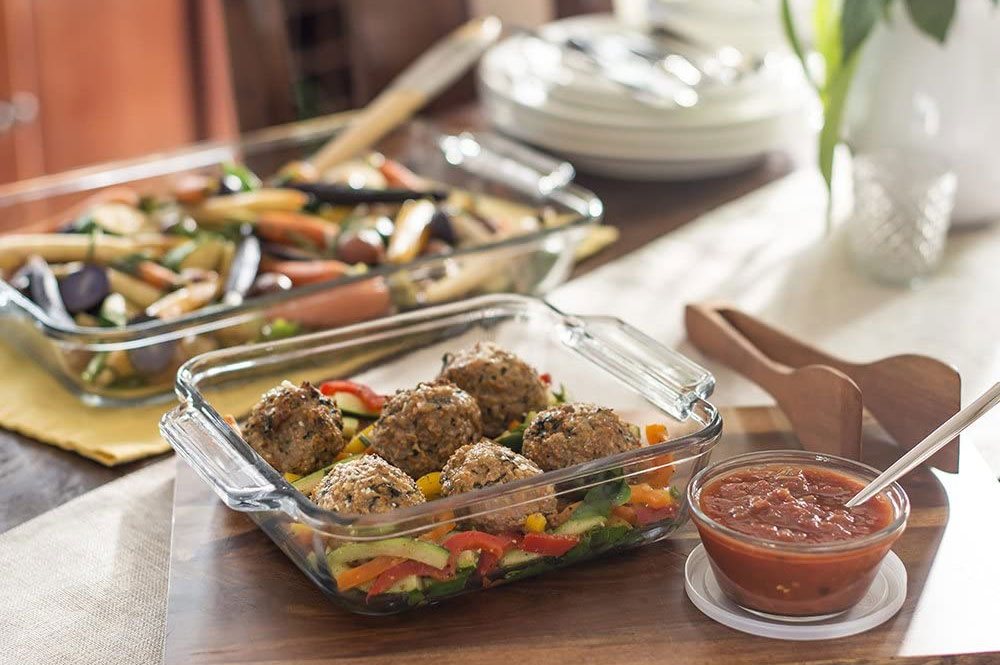
See American-made Anchor Hocking’s 15-piece glass bakeware set.
Glass isn't intended for all styles of cooking. You're not going to find pots and pans made of the stuff. Slow to heat, glass works as an insulator, meaning it may cook unevenly. This does mean it can be good as bakeware, though, especially for casseroles and dishes such as lasagna, for which you might actually desire a more solid or crispy edge.
Copper cookware
While beautiful to look at, copper is very expensive and doesn't frequently show up in cookware sets, except as the occasional finish applied to otherwise aluminum cookware. If the "copper" cookware you're looking at is affordable, chances are it's not 100% copper.
Some chefs, especially French traditional chefs, swear by copper cookware, but it probably isn't for the hobby chef at home. Unlike cast iron, carbon steel, and stainless steel, copper heats up fast, but it also doesn't retain its heat. It's just a very responsive metal. For most, this means copper cookware may be best suited for sauces, candy-making, and the cooking of other delicate foods.
Pros
- Lasts a lifetime
- Heats up fast, cools fast
Cons
- Very expensive
- Heavier than stainless, but not as heavy as cast iron
- Can heat up or cool down too fast
- Despite durability, also scratches easily
- Reactive metal prone to discoloration without care
- Not dishwasher safe, must be hand-washed
- Needs to be thick enough to cook evenly
- May need to watch for too much copper intake
What to look for in a cookware set
- Material quality and thickness. Better pots and pans will generally be thicker. This allows for even heat distribution, so you won't get hot spots, particularly on the edges or in the center of the cookware. The one exception to this rule is with cookware that has thick aluminum bottom plates. Test kitchens have found those can present their own problems and are best avoided.
- Safety and durability at high temperatures. The best cookware sets can comfortably and safely withstand cooking temperatures up to 500-600°F (260-315°C). Cheaper cookware sets tend to be oven safe at much lower temperatures. This doesn't mean they're bad, only that they're more likely to warp in extreme conditions or over time with normal use.
- Price. Affordable cookware sets can be a great way to get started in a new kitchen, but if you go with a cheap set, don't be surprised if you branch out from it in the future and buy nicer individual items. This doesn't mean there aren't really nice—and really expensive—cookware sets out there. And considering some cookware can last a lifetime, spending a little extra on this home good isn't the worst investment. Be prepared for some sticker shock, but take heart in knowing that the most expensive cookware often sports features and technologies that the average home cook won't find useful at all.
Cookware starter kit
Still too overwhelmed? We’ve got you covered.
- Get a good stainless steel cookware set for general purpose use, such as Cuisinart’s 12-piece set on the affordable end or All-Clad’s 10-piece set on the expensive end. The latter set will cook more evenly because of how it’s constructed, but both will be great. A stainless steel cookware set will cost slightly more upfront than a nonstick set, but stainless steel can take a beating and be restored, meaning it’ll last far longer. For those times when you truly need a nonstick cooking surface, go for individual nonstick pieces, like a good nonstick pan or pot, instead of a full set.

